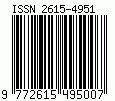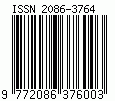“Gawaiâ€: Cultural Activities in the Shroud of Jangkang Bokidoh Dayak Tribe Traditional Architecture in Balai Sebut Village
DOI:
https://doi.org/10.26905/lw.v13i1.4816Keywords:
Local wisdom, Cultural Activity, Dayak Jangkang Bokidoh, Traditional ArchitectureAbstract
Balai Sebut Village located in Perintis Hamlet, Sanggau Regency, which has indigenous people, namely Dayak Jangkang Bokidoh. Local wisdom in those areas still closely held, either tangible, such as traditional architectural forms, or intangible, such as traditional and cultural activities. This study discusses the visual form of the traditional house, the pattern of micro-space arrangement and traditional activities that use the “Gawai†space. “Gawai†is a religious ceremony as a sense of gratitude which involves the use of micro to macro spaces. The purpose of this research is to focus on the identification of house forms, settlement patterns, and cultural activities that using an architectural space as an effort to preserve traditional architecture which is precisely in Perintis Hamlet. The research method was carried out in a descriptive-qualitative manner with an ethnographic approach. Data collection was carried out through a focus group discussion. The results showed that the Dayak Jangkang Bokidoh tribe had architectural tangible and intangible values. Physical spaces that have architectural value will have meaning if there are activities that involve the space. In this case, seven kinds of traditions are still preserved in Balai Sebut village, namely in the form of “Gawaiâ€, which are related to the presence of ancestors, gratitude for the harvest, birth, death, and marriage as cultural activities that must be preserved together with the traditional house. So, “Gawai†can be said as a cultural activity that gives meaning to space in the traditional architecture of the Jangkang Bokidoh Dayak Tribe.
Â
Downloads
References
Bambang, W., Ari, S., Susilo, K., & Widya Fransiska Febriati, A. (2016). Cultural Approach of Sustainability in Dwellings Culture Riparian Community Musi River Palembang. DIMENSI (Journal of Architecture and Built Environment), 43(2). doi:10.9744/dimensi.43.2.85-92
Bhattacherjee, A. (2012). Social Science Research: Principles, Methods, and Practices, (2nd edition ed.). Tampa, Florida, USA: University of South Florida.
Creswell, J. W. (2014). Research design : qualitative, quantitative, and mixed methods approaches (4 ed.). New Delhi: SAGE Publications
Fitriyani, I., Antariksa, A., & Wulandari, L. D. (2015). Penggunaan Ruang Pada Usaha Batik Tulis Di Kampung Batik Jetis Sidoarjo. RUAS (Review of Urbanism and Architectural Studies), 13(2), 47-59.
Ginzarly, M., Pereira Roders, A., & Teller, J. (2019). Mapping historic urban landscape values through social media. Journal of Cultural Heritage, 36, 1-11. doi:10.1016/j.culher.2018.10.002
Indeswari, A., Antariksa, A., Pangarsa, G. W., & Wulandari, L. D. (2013). Pola Ruang Bersama pada Permukiman Madura Medalungan di Dusun Baran Randugading. RUAS (Review of Urbanism and Architectural Studies), 11(1), 37-46.
Oliver, P. (1987). Dwelling The House Across The World, . UK: Phaidon Press Limited, Oxford.
Prabowo, A., Al-Ghifari, M. A. A., Fadlilah, F. N., Pakuan, G. M., & Zulfahmi, M. H. (2019). Identifikasi Material Berkelanjutan Pada Ruang Luar Dan Ruang Dalam Bangunan Kantor. Jurnal Arsitektur ZONASI, 2(3), 160. doi:10.17509/jaz.v2i3.19492
Prijotomo, J., & Pangarsa, G. W. (2010). Rong: Wacana Ruang Arsitektur Jawa. Ebook Engine. .
Putra, R. (2012). Dayak Djongkang : From Headhunters to Catolics, Studi dan Pendekatan Semiotika. Tangerang: UMN Press.
Rapoport, A. (1990). The Meaning of the Built Environment A Nonverbal Communication Approach. California: Sage Publications.
Rianty, H., & Jurumai, L. P. (2019). Tipologi Rumah Adat Dayak. Journal Malige (Media Arsitektur Lintas Generasi).
Rushton, H., Silcock, D., Rogers, J., & Schnabel, M. A. (2018, 13-15 June, 2018). The Tangible and Intangible: Interpreting Modern Architectural Heritage in Virtual Realities. Paper presented at the Tangible – Intangible Heritage(S) – Design, Social And Cultural Critiques On The Past, Present And The Future.
Santoso, D. K., & Wikantyoso, R. (2018). Faktor Penyebab Perubahan Morfologi Desa Ngadas, Poncokusumo, Kabupaten Malang. Local Wisdom Scientific Online Journal, 10(2).
Setyabudi, I. (2011). Nilai guna ruang rumah tinggal suku Using Banyuwangi dalam kegiatan sosial, budaya dan agama. Local Wisdom Scientific Online Journal, 3(2).
Suhendro, R., Hanye, P., & Patriantoro. (2019). Afiks dalam Bahasa Dayak Jangkang Kecamatan Jangkang Kabupaten Sanggau. Jurnal Pendidikan dan Pembelajaran, 8(3).
Sumalyo, Y. (1993). Arsitektur Kolonial Belanda di Indonesia. Yogyakarta: Gadjah Mada University Press.
Wesnawa, I. G. A. (2010). Dinamika Pemanfaatan Ruang Berbasis Kearifan Lokal di Kabupaten Buleleng Provinsi Bali. Forum Geografi, Vol. 24 (No. 1).
Wijaya, I. K. M. (2020). The Local Wisdom Study of Luan And Teben Concept on Balinese Ethnic Houses (Case Study: Balinese Ethnic Houses in Denpasar, Bali). Local Wisdom : Jurnal Ilmiah Kajian Kearifan Lokal, 12(2). doi:10.26905/lw.v12i2.4276












